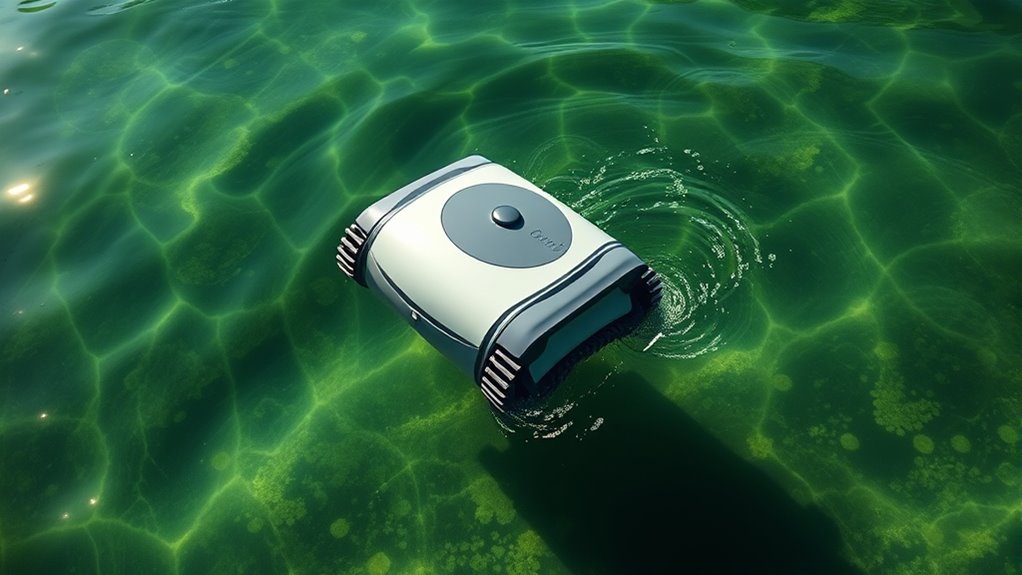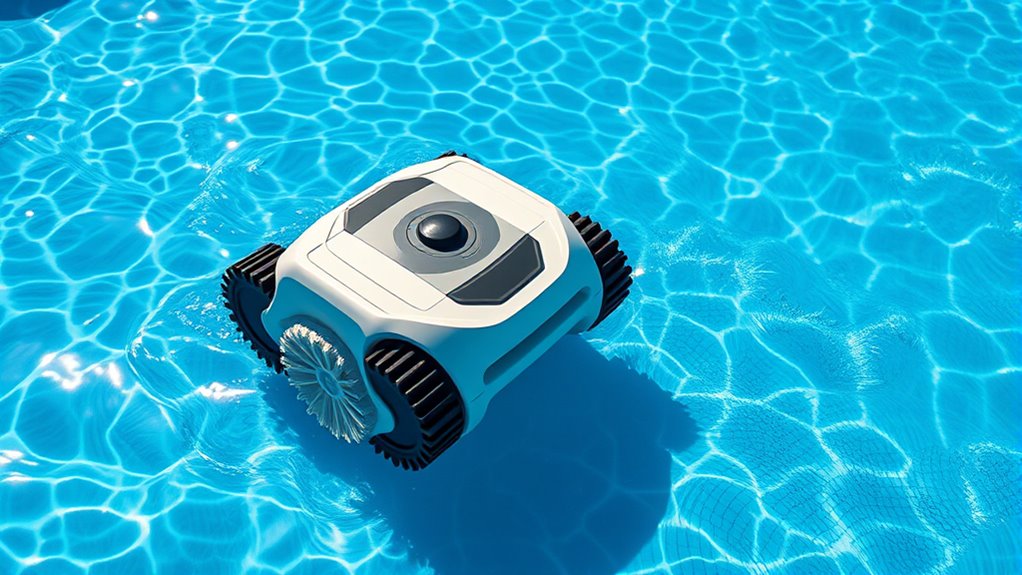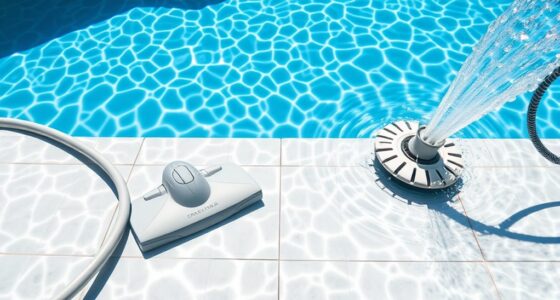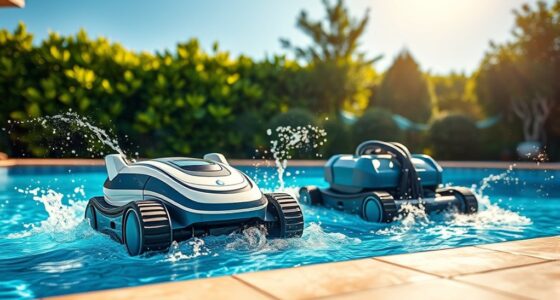Automatic pool cleaners can effectively remove surface debris, dirt, and large particles, helping with overall pool cleanliness. However, they can’t eliminate microscopic algae or fully clear up cloudy water on their own. To address algae and transparency issues, you’ll need to combine the cleaner’s use with proper chemical treatments like algaecides and shock. If you’re interested in learning specific strategies to keep your pool sparkling, keep exploring the tips and techniques available.
Key Takeaways
- Robotic pool cleaners effectively remove surface debris but cannot eliminate microscopic algae causing cloudiness.
- They assist in cleaning algae on pool surfaces but do not replace chemical treatments like algaecides.
- Cloudy pools often result from dirt, algae, and minerals; cleaners improve clarity but need chemical balancing.
- Regular use of robotic cleaners speeds up debris removal but must be combined with proper filtration and chemistry.
- For algae control, chemical treatments are essential; robotic cleaners complement but do not replace these processes.

Automatic pool cleaners have revolutionized how you maintain your pool, making it easier and more efficient to keep your swimming area spotless. These devices are designed to handle the regular cleaning tasks, but when it comes to algae and cloudy water, you might wonder if they’re up to the challenge. The answer depends on the type of cleaner you choose and its features. Many modern robotic cleaners use advanced robotic navigation systems, allowing them to move methodically across your pool’s surface, targeting debris pickup with precision. This means they can cover the entire area quickly, removing leaves, dirt, and larger particles that can contribute to cloudiness. However, when algae blooms or cloudy water occur, these cleaners often need some additional help.
Robotic navigation plays a vital role here. A well-equipped robotic cleaner can navigate around corners, steps, and tight spots, ensuring thorough coverage. It’s particularly effective at picking up visible debris, dirt, and even some smaller particles that can cloud the water. Yet, algae is a different challenge altogether. While the cleaner can physically remove algae on the surface and the pool floor, it doesn’t eliminate the microscopic algae that often cause the water to turn green or cloudy. For algae, you’ll typically need to rely on proper chemical treatment, such as algaecides and shock treatments, to kill the algae cells. Once the algae are dead, a good robotic cleaner can assist in removing the dead algae, helping to clarify the water faster.
Robotic cleaners remove surface debris but require chemical treatments to eliminate microscopic algae.
Cloudy pools often result from a combination of dirt, algae, minerals, and insufficient filtration. A robotic cleaner can improve water clarity by removing surface and bottom debris, but it’s not a substitute for maintaining your filtration system or balancing your pool chemistry. Regularly cleaning your filters, balancing pH levels, and shocking the pool are essential steps. Combining these practices with a robotic cleaner that offers debris pickup and thorough coverage can considerably shorten the time needed to clear up cloudy water. Additionally, using a smart filtration system can optimize water flow and enhance clarity.
In essence, automatic pool cleaners are valuable tools for maintaining cleanliness, especially when it comes to debris pickup and routine cleaning. They’re effective at removing dirt and visible particles that contribute to cloudiness, but algae control requires chemical treatments. For best results, use your robotic cleaner as part of a detailed pool maintenance plan that includes proper chemical balancing and filtration. Incorporating advanced fraud detection techniques, such as predictive analytics and geolocation data, into your maintenance routine can help prevent issues before they arise. Additionally, choosing a high-quality robotic cleaner with smart navigation features can enhance overall efficiency. When used together, these strategies can make your pool sparkle again, even after algae blooms or cloudy water episodes.
Frequently Asked Questions
How Often Should I Run My Automatic Pool Cleaner?
You should run your automatic pool cleaner at least once a week to maintain ideal pool chemistry and guarantee effective debris removal. If your pool gets heavy use or has lots of leaves and dirt, consider running it more often, like twice a week. Regular cleaning helps prevent algae buildup and keeps your water clear. Adjust your schedule based on pool usage and debris levels to keep your pool sparkling.
Can Automatic Cleaners Remove Algae From Pool Walls Effectively?
Automatic pool cleaners can help with algae removal and wall cleaning, but they might not be enough alone. They’re effective at scrubbing pool walls and removing debris, but algae often cling stubbornly. To tackle algae effectively, you should brush the walls manually first, then run your cleaner regularly to maintain cleanliness. Combining manual cleaning with your automatic cleaner guarantees your pool stays clear and algae-free.
Are There Specific Models Better for Cloudy Water?
Imagine the perfect summer day, but cloudy water ruins it—sounds familiar? Some models are more efficient at algae removal and tackling cloudy pools. Look for automatic cleaners with advanced filtration and strong brushes, as they’re designed for better model efficiency. These features help break down algae and clear up murky water faster. Choosing the right model makes your pool cleaning effortless, so you can enjoy your pool without worries.
Do Automatic Pool Cleaners Require Regular Maintenance?
You need to regularly maintain your automatic pool cleaner to keep it working efficiently. Proper maintenance involves checking the pool chemical balance, which prevents algae and cloudiness, and cleaning debris filtration systems to avoid clogs. Regularly inspecting hoses, brushes, and filters ensures peak performance. By staying on top of these tasks, your cleaner will effectively handle debris and keep your pool clean and clear.
Can Automatic Cleaners Prevent Future Algae Growth?
Did you know that 60% of pool owners struggle with algae buildup? Automatic pool cleaners can help with algae prevention by removing debris that fuels algae growth, but their effectiveness varies. While they can’t fully prevent algae on their own, using a cleaner regularly complements proper chemical balance, reducing algae chances. So, investing in a good cleaner supports your efforts to keep your pool clear and algae-free.
Conclusion
While automatic pool cleaners are like diligent garden tenders, they excel at removing dirt and debris but often fall short against stubborn algae and cloudy waters. Think of them as skilled sailors steering calm seas, yet struggling against stormy currents. To restore your pool’s sparkle, combine their efforts with specialized treatments. By doing so, you’ll transform your pool into a shimmering oasis—an inviting mirror reflecting the effort and care you pour into it.









